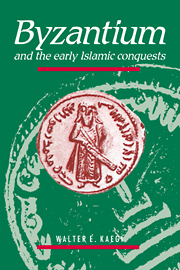Book contents
- Front Matter
- CONTENTS
- List of illustrations
- Preface
- List of abbreviations
- Chapter 1 The problem of Byzantium and the early Islamic conquests
- Chapter 2 The Byzantine Empire in an era of accelerating change
- Chapter 3 Difficulties in devising defenses for Syria
- Chapter 4 The first Muslim penetrations of Byzantine territory
- Chapter 5 Early tests in southern Palestine
- Chapter 6 Problems of cohesion: the battle of Jābiya- Yarmūk reconsidered
- Chapter 7 The brief struggle to save northern Syria and Byzantine Mesopotamia
- Chapter 8 Byzantium, Armenia, Armenians, and early Islamic conquests
- Chapter 9 Controversy and confidence in the seventh-century crisis
- Appendix 1 Author and date of the anti-jewish treatise
- Chapter 10 Elements of failure and endurance
- Bibliography
- Index
Chapter 4 - The first Muslim penetrations of Byzantine territory
Published online by Cambridge University Press: 22 September 2009
- Front Matter
- CONTENTS
- List of illustrations
- Preface
- List of abbreviations
- Chapter 1 The problem of Byzantium and the early Islamic conquests
- Chapter 2 The Byzantine Empire in an era of accelerating change
- Chapter 3 Difficulties in devising defenses for Syria
- Chapter 4 The first Muslim penetrations of Byzantine territory
- Chapter 5 Early tests in southern Palestine
- Chapter 6 Problems of cohesion: the battle of Jābiya- Yarmūk reconsidered
- Chapter 7 The brief struggle to save northern Syria and Byzantine Mesopotamia
- Chapter 8 Byzantium, Armenia, Armenians, and early Islamic conquests
- Chapter 9 Controversy and confidence in the seventh-century crisis
- Appendix 1 Author and date of the anti-jewish treatise
- Chapter 10 Elements of failure and endurance
- Bibliography
- Index
Summary
THE INVASIONS AND ASSUMPTIONS ON CHRONOLOGY
Abū 'Ubayda b. Jarrāh advanced until he traversed the Wādīl Qurā and then he approached Hijr and it is a place of the Banū Salih…and it belongs to the Hijāz and what is beyond Hijr belongs to Syria. And he advanced to Dhāt Manār and then to Zīzā. Then he proceeded to Ma'āb in the territory of 'Ammān. The Romans [Byzantines] sallied forth against them and the Muslims continued routing them until they forced them to enter their town [of Ma'āb] and the Muslims besieged them in it. The people of Ma'āb made peace [sulh] and it was the first city in Syria that made peace with the Muslims.
Such is Azdī's account of the initial permanent Muslim penetration of Byzantine territory by the Muslim commander Abū 'Ubayda b. Jarrāh, who followed a traditional trade route from Medina to Syria. His description correlates with the earliest Christian narrative of the Muslim invasions, that of the Armenian Sebēos, as well as with traditions reported by al-Ţabarī and al-Balādhurī.
Many chronological and historiographical problems complicate investigation of the last moments of Byzantine rule in Palestine and Syria and the final years of the reign of Heraclius. Yet it is possible to find some wellattested events. In February and March 628 Heraclius crushed the Persians, whose sovereign Chosroes II was overthrown and assassinated by his own son Siroes.
- Type
- Chapter
- Information
- Byzantium and the Early Islamic Conquests , pp. 66 - 87Publisher: Cambridge University PressPrint publication year: 1992
- 1
- Cited by

